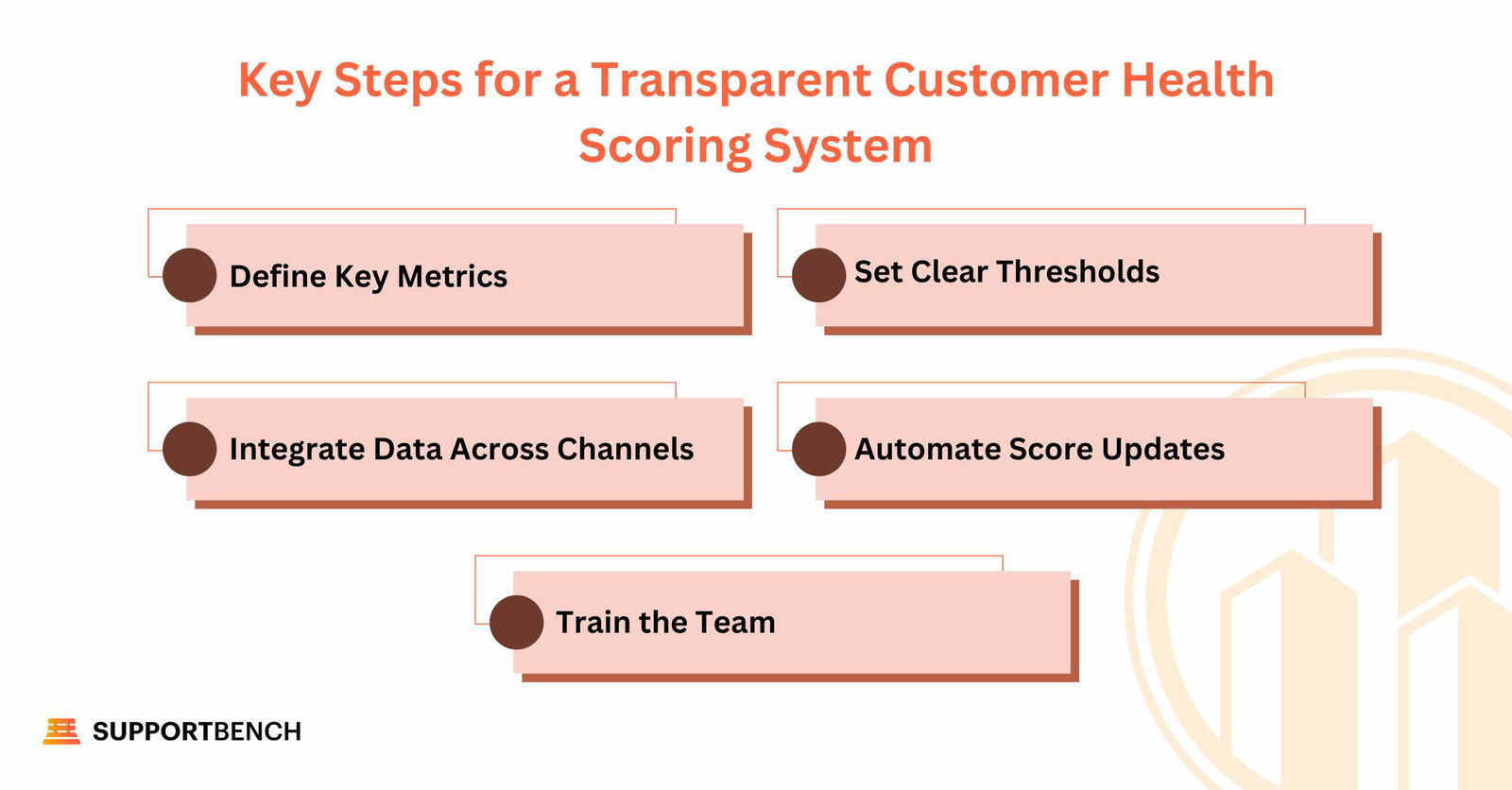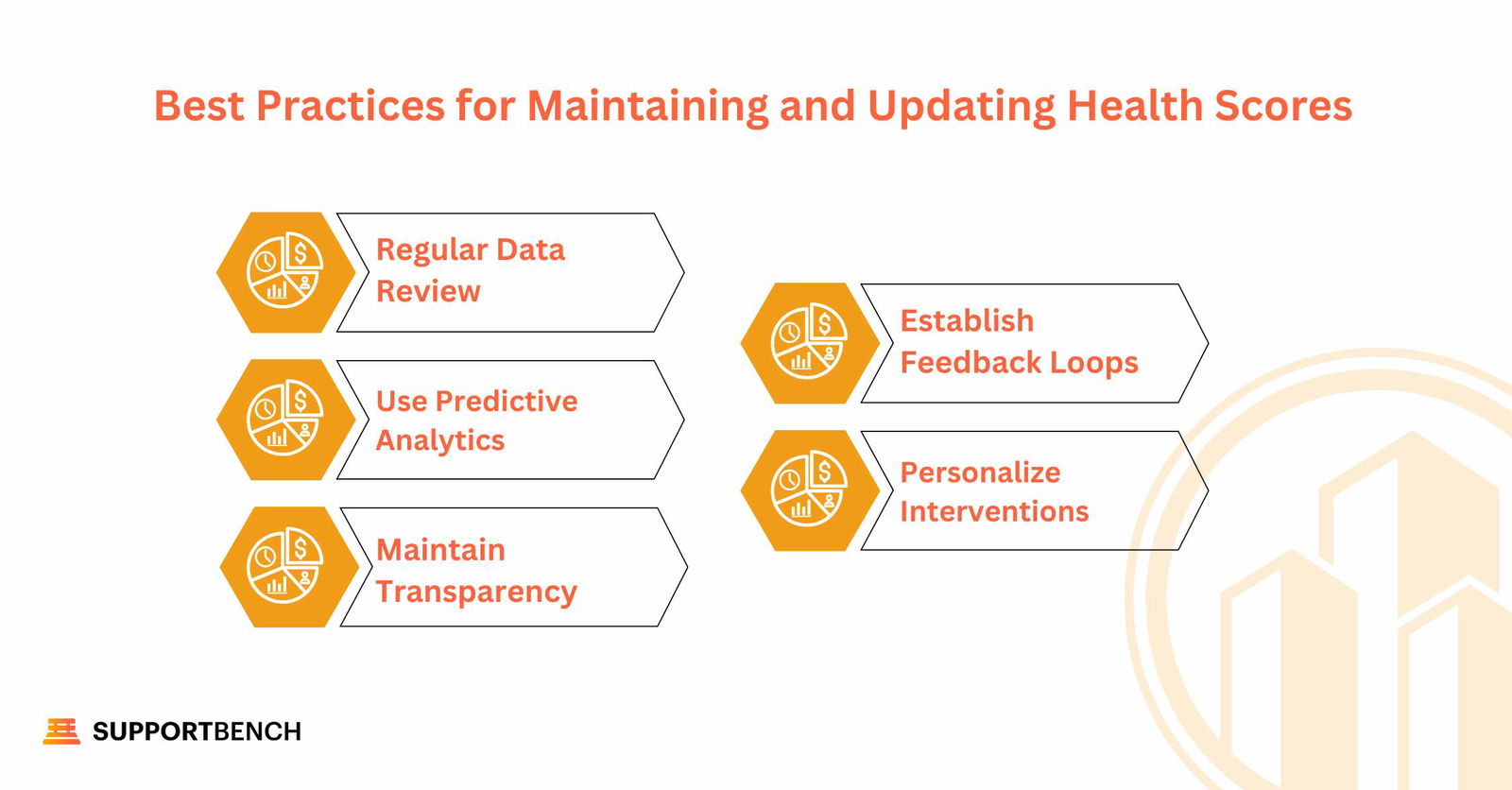In the B2B enterprise landscape, trust is essential for fostering strong customer relationships. Transparency and understanding form the foundation of this trust, with customer health scoring serving as a vital tool.
Supportbench, a leader in customer support innovation, highlights the pivotal role customer health scoring plays in strengthening these connections.

What is customer health scoring, and what is its role in building trust?
Customer health scoring goes beyond being a simple metric; it is a strategic tool that offers deep insights into the customer’s experience, needs, and expectations.
Transparent customer health scoring enables businesses to provide a clearer view of their relationship with each customer. This openness fosters trust by helping support teams understand and address customer needs proactively.
In 2025, implementing transparent customer health scoring strategies will be essential for customer support leaders. These strategies allow businesses to monitor the customer journey, anticipate issues before they arise, and maintain strong relationships through actionable insights and open communication.
Ultimately, trust in customer support is built through transparency and understanding. As we approach 2025, leveraging these strategies will remain pivotal for enhancing relationships and ensuring long-term customer satisfaction.
Understanding Customer Health Scoring
Customer health scoring assesses a customer’s overall satisfaction and well-being by combining various metrics to provide a comprehensive view of their relationship with a business. Common metrics include:
- Product Usage: Frequency and depth of product or service use.
- Customer Feedback: Survey responses, reviews, and net promoter scores (NPS).
- Support Interaction: Number of support tickets, response times, and resolution satisfaction.
- Financial Data: Purchase history, subscription renewals, and payment timeliness.
- Engagement Levels: Participation in webinars, events, and content consumption.
Benefits of Transparent Health Scoring for Customers and Support Teams
Transparent customer health scoring benefits both customers and support teams by fostering personalization and proactive engagement.
- For Customers: Transparent scoring enables support teams to anticipate and address potential issues early, leading to a more satisfying experience and improved retention rates.
- For Support Teams: Actionable insights from health scores help prioritize efforts, ensuring high-risk customers receive focused attention. This improves overall customer satisfaction while optimizing resource allocation within the support department.
What are the key tactics for customer support leadership in 2025?
As customer support leadership evolves, staying ahead requires adopting innovative tactics that harness the latest technologies and strategies. The rapidly changing customer service landscape in 2025 presents opportunities to enhance satisfaction and operational efficiency.
Transparent customer health metrics are essential for building trust. These metrics provide valuable insights into customer experiences and expectations, enabling support teams to address issues proactively. Below are the key tactics for customer support leadership in the upcoming year.

Leverage AI and Predictive Analytics
AI-driven customer support solutions and predictive analytics are crucial for staying competitive. AI analyzes customer data to generate transparent health metrics, enabling support teams to anticipate issues before escalation. Predictive analytics ensures proactive problem-solving, leading to a smoother customer experience and higher satisfaction rates.
Tools like Supportbench use AI to analyze customer interactions, feedback, and health scores, providing insights that help tailor customer experiences and predict future needs. These technologies allow businesses to address potential churn, understand customer moods, and resolve issues early.
Autonomous and Scalable Customer Support Infrastructure
An autonomous infrastructure leverages automation and AI to handle routine tasks, enabling agents to focus on complex issues. Tools such as FAQs, intelligent chatbots, and interactive knowledge bases empower customers to resolve issues independently, enhancing autonomy.
Scalable systems adapt to business growth, handling increasing inquiries and integrating with CRMs and analytics tools without compromising service quality. Supportbench’s GPT-powered chatbot delivers immediate assistance, reducing wait times and improving customer satisfaction.
Enhance Personalization
Personalization lies at the heart of customer success strategies. Data-driven insights allow support teams to move away from generic approaches, creating individualized experiences tailored to customer needs.
Transparent health scores provide a holistic view of each customer, incorporating key metrics such as product usage, past interactions, and payment history. For example, a drop in a customer’s health score can indicate dissatisfaction, prompting a proactive check-in or customized support solution.
Hyper-personalization further strengthens loyalty by tailoring every interaction to the individual, addressing pain points and delivering relevant solutions. Tools like Supportbench, with customizable dashboards and reports, enable teams to identify customer health trends and target areas needing attention effectively.

Promote Transparency
Transparency in customer support fosters trust and credibility. Sharing customer health scores and explaining how they are calculated demonstrates a commitment to customer satisfaction.
Transparent health metrics empower customers with insights into their interactions, creating a sense of partnership and enhancing the perceived value of support. This builds stronger relationships and reinforces trust between customers and businesses.
Integrate Omnichannel Support
Integrating data from multiple platforms ensures consistent health scoring across all customer interaction channels. This enables businesses to consolidate information from various sources and maintain accurate, up-to-date health scores.
A unified view of customer interactions allows support teams to make informed decisions, delivering personalized support regardless of the communication channel. This integration enhances the overall customer experience and ensures seamless engagement.
Focus on Proactive Engagement
Proactive engagement is essential for customer satisfaction and retention. Use health scores to identify at-risk customers and address their needs proactively. Personalized outreach and targeted support initiatives prevent issues from escalating, resolving problems faster and strengthening customer relationships.
This approach demonstrates that customers’ needs are anticipated and addressed, boosting satisfaction rates and fostering long-term loyalty.
Case Study: Leveraging Customer Health Metrics at Voter Voice
At Voter Voice, customer support leadership transformed the service experience by implementing transparent customer health metrics. Previously, the account team reviewed customer status just before renewal—often too late to address critical issues effectively.
The introduction of a health scoring system enabled the team to identify and address problems earlier. For example, when a customer’s score entered the red zone, the team pinpointed several issues, including onboarding gaps, failed product integrations, and irrelevant content delivery. Transparent health metrics provided a clear snapshot of the customer’s status, allowing the success manager to intervene proactively.
Cross-department collaboration was pivotal in resolving these concerns. The account manager addressed the product integration issues, while marketing adjusted the content strategy to better meet the client’s needs.
The impact was immediate. Using health score data, the success manager initiated a timely conversation with the client, improving their overall experience and satisfaction.
Impact on Customer Trust and Business Outcomes
By leveraging transparent customer health metrics, Voter Voice significantly strengthened customer trust. Early identification of issues enabled proactive interventions, demonstrating to customers that their concerns were valued and addressed promptly.
From a business perspective, addressing problems early prevented churn and reduced inefficiencies. The streamlined process saved resources while improving customer retention. This proactive approach not only enhanced customer relationships but also contributed positively to overall revenue growth.
Implementation Steps for a Transparent Customer Health Scoring System
A transparent customer health scoring system strengthens customer relationships and drives measurable business outcomes. Follow these steps to establish a robust system and ensure its ongoing effectiveness.

Define Key Metrics
Identify the metrics that best reflect your customer’s overall health. These may include:
- Product usage patterns.
- Quality of support interactions.
- Payment history and subscription renewals.
- Customer satisfaction scores and survey feedback.
Ensure these metrics align with your business objectives and customer success goals for meaningful insights.
Set Clear Thresholds
Establish clear thresholds for health scores to classify customers into actionable categories, such as:
- Green: Healthy customers with no immediate issues.
- Yellow: Customers needing attention to avoid potential dissatisfaction.
- Red: At-risk customers requiring urgent intervention.
These thresholds enable teams to take appropriate actions quickly.
Integrate Data Across Channels
Consolidate data from all customer interaction channels to maintain consistent and accurate health scores. This includes:
- Customer service tickets.
- Product usage logs.
- CRM integrations and engagement metrics.
Centralized data ensures a unified view of customer health for more informed decisions.
Automate Score Updates
Automate the updating of customer health scores with real-time data inputs. This allows:
- Immediate identification of potential issues.
- Faster response times for at-risk customers.
- Reduced manual errors and increased efficiency.
Real-time updates empower teams to act proactively.
Train the Team
Provide comprehensive training to your team on effectively utilizing health scores. This includes:
- Understanding the metrics and their significance.
- Interpreting health score thresholds.
- Taking tailored actions based on score categories.
Well-trained teams can better leverage health scoring to optimize customer success strategies.
Best Practices for Maintaining and Updating Health Scores
To ensure your customer health scoring system remains effective and relevant, it’s crucial to adopt best practices for regular maintenance and updates. These strategies will help keep your health scores aligned with evolving customer expectations and business objectives.

Regular Data Review
Review and refine your health scoring model periodically to reflect changes in customer behavior, expectations, and business goals. Regular updates ensure your system stays accurate and responsive to shifting priorities.
Use Predictive Analytics
Leverage predictive analytics to forecast potential issues such as customer dissatisfaction or churn. Proactive insights allow your team to manage relationships effectively and prevent problems before they arise.
Maintain Transparency
Ensure that your health scoring system remains transparent within your organization. Clearly communicate the metrics and methods behind the scores to foster a consistent understanding among team members and align efforts in addressing customer concerns.
Establish Feedback Loops
Incorporate feedback loops with cross-functional teams, such as customer success, support, and product teams. Regular collaboration ensures the scoring system remains effective and adaptable to operational needs while resolving customer issues swiftly.
Personalize Interventions
Develop tailored intervention strategies based on health scores:
- High Scores: Require less frequent monitoring and standard check-ins.
- Declining Scores: Indicate the need for targeted outreach, personalized support, and proactive resolution of potential pain points.
Personalized actions reinforce customer trust and satisfaction, ultimately driving loyalty.
The Revolutionary Aspect of Supportbench
Supportbench redefines customer support by prioritizing transparency, innovation, and autonomy. Through advanced AI technologies, the platform delivers a comprehensive suite of tools designed to help support teams resolve issues efficiently while fostering long-term customer relationships.
Why Supportbench is Significant for Your Company
Supportbench is a transformative platform that elevates customer support with innovative features, a data-driven approach, and a focus on transparency.
Here’s why Supportbench stands out:
- Enhanced Customer Relationships: Transparent customer health metrics provide clear insights into each customer’s journey, fostering trust and deeper connections.
- Data-Driven Decisions: Real-time data insights empower teams to make informed decisions that align with both customer needs and business goals.
- Efficiency and Autonomy: Supportbench minimizes reliance on IT and other departments by offering tools that enhance team independence and overall productivity.
Conclusion
To thrive in the ever-evolving customer support landscape, B2B enterprises must prioritize strategies that build trust and enhance customer satisfaction.
Transparent customer health scoring enables businesses to proactively manage relationships, address issues before they escalate, and consistently optimize customer experiences through data-driven insights.
Supportbench empowers customer support teams with innovative tools to streamline operations, improve data visibility, and foster lasting customer relationships. By leveraging AI-driven insights, automating routine tasks, and incorporating feedback loops, businesses can refine service delivery and stay ahead of customer needs.
As we enter 2025, transparent customer health scoring is no longer just a trend—it is essential for building trust and loyalty. Integrating actionable health score systems allows businesses to better understand their customers, anticipate their needs, and deliver personalized support. Embrace this strategy to strengthen customer relationships and drive sustainable growth and success.















